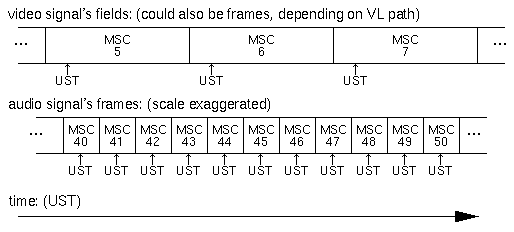
This document describes the UST support in the VL, AL, GL, CL, MD, tserialio, DM, and other libraries (see What Are the SGI Video-Related Libraries?).
For a taste of why synchronization is hard and how the UST support solves the problem, see Why Use UST?.
You can perform all of the timing and synchronization tasks listed above by simply comparing USTs you get from or give to different subsystems. For example:
typedef struct __mdevent {
char msg[4];
char *sysexmsg;
long long stamp; /* time stamp in ns */
int msglen; /* length of data, sysex only */
} MDevent;
The MDevent contains a MIDI event and a field "stamp" that identifies the
time of that event. The library supports lots of different stamp modes
that affect the interpretation of "stamp," but the one you want to use
is the simplest one:
{
MDport port;
/* ... open port ... */
mdSetStampMode(port, MD_RELATIVESTAMP);
mdSetStartPoint(port, 0, 0);
/* ... send or receive MIDI ... */
}
In this mode, "stamp" is simply a UST time.
To receive data, you call mdReceive() and you get back an MDevent with the event and UST stamp filled in. To send data, you provide an MDevent to mdSend(), and the MIDI subsystem will output the specified MIDI message at the specified UST.
When you receive a field or frame in a DMbuffer using the O2 or cross-platform VL buffering API (see What Are the SGI Video-Related Libraries? for more info), you can pass the DMbuffer into dmBufferGetUSTMSCpair(). This returns a USTMSCpair structure. USTMSCpair.ust contains the UST of the field or frame. USTMSCpair.msc contains a coincident snap of a counter that increments once per buffer time (field or frame, depending on the time spacing of the data in your buffers). You can tell if you dropped any data by seeing if USTMSCpair.msc has incremented by more than 1. This MSC counter has some useful properties which we describe below along with UST/MSC.
The VL also supports UST/MSC, another API for determining the UST of data which works for input and output. We describe UST/MSC below.
We will explain how to distinguish dominant and non-dominant fields
along with UST/MSC below.
This function provides one possible way to relate the UST clocks
of two different machines. See Synchronization
Across Machines for more information.
As a result of this, you can think of your signal as having discrete
"slots" which each hold one unit of data. Here's an example with an audio
and video signal:

The UST of a slot is the UST of the synchronization point of the data in that slot (see How to Use UST above). Each slot in a given signal is numbered with an MSC ("media stream count" or "media sequence count").
If your program inputs a sampled signal, your job is to read the data out of each slot. If your program outputs a sampled signal, your job is to place the right data into each slot. In both cases, you need a way to figure out the UST of any given slot.
The UST/MSC support in the AL and VL consists of two operations
which let you do this:
Until we say otherwise, this document will assume that your program
reads or writes every slot. On input, this means that you read data out
of your buffer frequently enough that the device always has room to deposit
new data, so no data is ever dropped. On output, this means that you write
data to your buffer frequently enough that the device will never starve
for data, so the output will never glitch (e.g., audio click, video flash
or pause). As we'll see later, the frontier MSC is also useful for detecting
these error conditions.
{
double ust_per_msc = get_ust_per_msc();
USTMSCpair pair = get_ust_msc_pair();
stamp_t frontier_msc = get_frontier_msc();
/* step 1: figure out which MSC you want a UST for */
stamp_t desired_msc = frontier_msc;
/* step 2: compute the UST of that MSC */
stamp_t desired_ust = pair.ust + ust_per_msc*(desired_msc - pair.msc);
}
When extrapolating from a UST/MSC pair as above, be careful to use sufficiently
precise C types which will not overflow.
Determining the ust_per_msc figure can sometimes be tricky, because of various idiosyncrasies of audio hardware, video hardware, and video itself. Each library provides a simple way to get a nominal ust_per_msc figure. For any UST/MSC device, you can also measure ust_per_msc empirically instead of computing the nominal ust_per_msc figure. This often has accuracy advantages and works for any sync source. We will describe this more fully in Clocking and Clock Drift: Relating Multiple MSC or UST Clocks below.
You don't have to compute ust_per_msc or get a UST/MSC pair every time you read or write data. Typically, applications compute ust_per_msc only once, and get a new UST/MSC pair every second or so.
MSC values you get from a particular AL port or VL path are specific to that port/path only. For example, if you input the same video signal using two different VL paths, you must not assume that MSC 123 on one path refers to the same video field/frame as MSC 123 on the other path. When you need to compare the time of data on two different paths or ports, convert to UST.
After giving the specifics of UST/MSC for each library, we will
provide some pictorial examples of the above pseudocode.
| type of data in each slot (MSC) | one audio frame |
| time spacing of each slot (MSC) | one audio frame period |
| read (dequeue) | alReadFrames() |
| write (enqueue) | alWriteFrames() |
| get frontier MSC | alGetFrameNumber() |
| get UST/MSC pair | alGetFrameTime() |
| get nominal UST per MSC | sample code below |
To get a nominal ust_per_msc figure, do this:
{
ALpv pv;
double samprate;
double ust_per_msc;
pv.param = AL_RATE;
if (alGetParams(res, &pv, 1) < 0 || pv.value.ll <= 0)
{
/* cannot determine nominal sample-rate */
}
else
{
samprate = alFixedToDouble(pv.value.ll);
ust_per_msc = 1.E9 / samprate;
}
}
The "res" parameter to alGetParams() is the resource id of your AL clock
generator, your AL device that uses that clock generator, or your AL port
that uses that device.
The alGetParams() call will succeed but return a negative sampling rate if the nominal sample-rate cannot be determined. This only happens if the AL device's clock generator's master clock is an AES or ADAT digital signal which does not contain rate information (e.g. an AES source which has not set the rate bits in the subcode).
You can measure ust_per_msc instead, which works in every case
and gives you a more accurate figure. This will be described in Clocking
and Clock Drift: Relating Multiple MSC or UST Clocks below.
| type of data in each slot (MSC) | one buffer entry (VLInfoPtr or DMbuffer) |
| time spacing of each slot (MSC) | VL_RATE (which is in buffer entries per second) |
| read (dequeue) | vlGetNextValid() or vlEventRecv() |
| write (enqueue) | vlPutValid() or vlDMBufferSend() |
| get frontier MSC | vlGetFrontierMSC() |
| get UST/MSC pair | vlGetUSTMSCPair() |
| get nominal UST per MSC | vlGetUSTPerMSC() |
| VL_TIMING | VL_CAP_TYPE | required VL_RATE |
|---|---|---|
| 525-line | VL_CAPTURE_NONINTERLEAVED or
VL_CAPTURE_FIELDS |
60/1 |
| VL_CAPTURE_INTERLEAVED | 30/1 | |
| VL_CAPTURE_EVEN_FIELDS | 30/1 | |
| VL_CAPTURE_ODD_FIELDS | 30/1 | |
| 625-line | VL_CAPTURE_NONINTERLEAVED or
VL_CAPTURE_FIELDS |
50/1 |
| VL_CAPTURE_INTERLEAVED | 25/1 | |
| VL_CAPTURE_EVEN_FIELDS | 25/1 | |
| VL_CAPTURE_ODD_FIELDS | 25/1 |
| Timing | VL_CAP_TYPE | MSC rate | MSC increment
per buffer |
|---|---|---|---|
| Interlaced | VL_CAPTURE_NONINTERLEAVED or
VL_CAPTURE_FIELDS |
once per
field |
1 |
| VL_CAPTURE_INTERLEAVED | once per
2 fields |
1 | |
| VL_CAPTURE_EVEN_FIELDS or
VL_CAPTURE_ODD_FIELDS. |
once per
2 fields |
1 | |
| Progressive | not supported | ||
| Timing | VL_CAP_TYPE | MSC rate | MSC increment
per buffer |
|---|---|---|---|
| Interlaced | VL_CAPTURE_NONINTERLEAVED or
VL_CAPTURE_FIELDS |
once per
field |
1 |
| VL_CAPTURE_INTERLEAVED or
VL_CAPTURE_EVEN_FIELDS or VL_CAPTURE_ODD_FIELDS. |
once per
field |
2 | |
| Progressive | VL_CAPTURE_INTERLEAVED | once per
frame |
1 |
For VL_CAPTURE_FIELDS paths, the device may skip an even or odd
number of fields during an input overflow, output underflow, or input signal
problem. Therefore, you need a way to determine what field type you are
currently enqueuing or dequeuing. This is currently only possible on vino,
ev1, ev3, and mvp, where you can use any of DMediaInfo->sequence, USTMSCpair.msc,
or an MSC from UST/MSC to determine the field type:
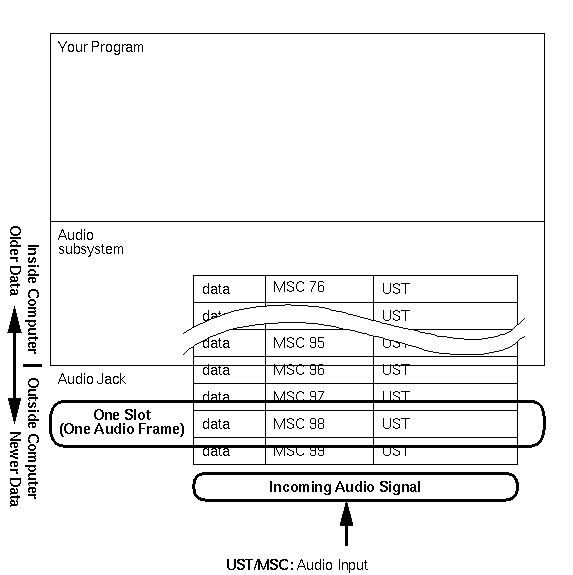
This diagram shows your program sitting atop the audio subsystem (the AL and the audio hardware). We show an incoming audio signal as a stack of slots, each of which holds one frame of audio. Some of those frames have not entered the computer yet, and some are sitting in the computer waiting for you to read them. As in the diagram above, each slot has an MSC and a UST. The UST is the UST at which the data in that slot will hit, or did hit, the audio input jack of the machine.
The next thing your program does is to read some data with alReadFrames:
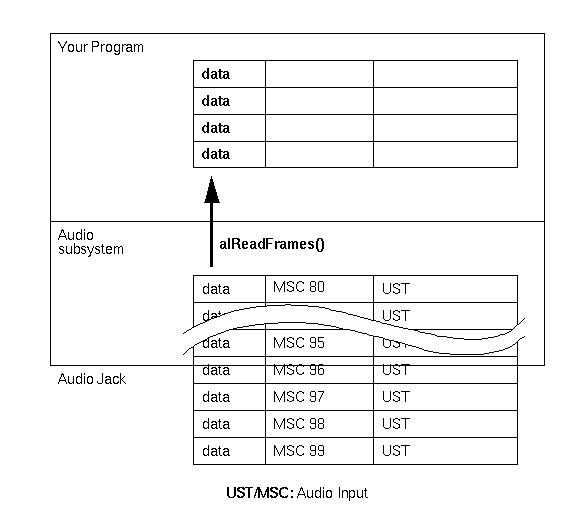
The AL examples in this document will use reads and writes of 2-5 frames for typographical convenience. Typical programs transfer 10ms or more of audio frames with each alReadFrames() or alWriteFrames(). UST/MSC works the same either way.
Now you have some data. The next thing you need to do is figure
out the MSC of each of your frames. You do that with one call to alGetFrameNumber():
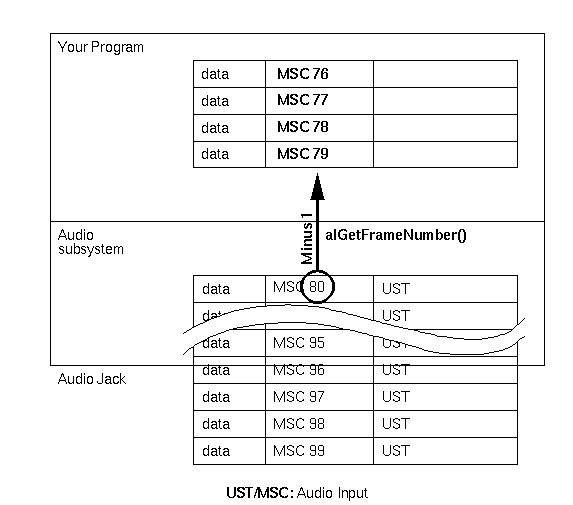
alGetFrameNumber() returns a frontier MSC of 80. This is the MSC of the next frame you're about to read from the port. Since audio frames come at regular intervals, and since we're assuming that we read the data out of every slot of the signal (ie, we never drop any audio frames on input), we then know that the MSCs of the 4 frames we just read are 76, 77, 78, and 79.
Now that we know the MSC of each of our frames, we can figure out the UST of each of the frames using alGetFrameTime():
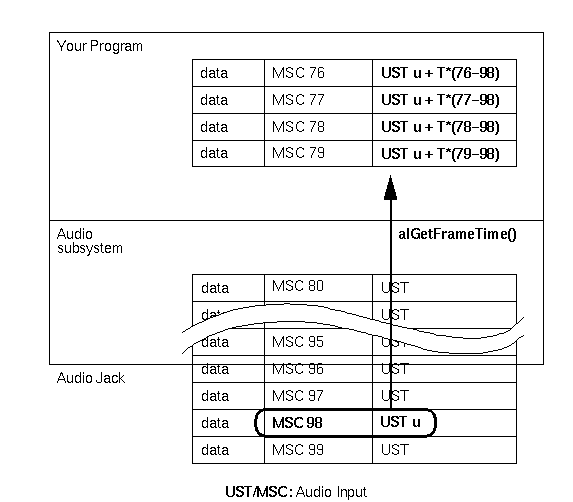
alGetFrameTime() returns a pair of numbers to us: MSC 98 and UST u. This tells us that MSC 98 hits the jack at UST u. We want to know when MSC 76, 77, 78, and 79 hit the jack. We find the UST of MSC 76 by taking u and adjusting it by (76-98) audio frame periods. The audio frame period T is (1/audio sampling rate) in nanoseconds. T is the same as ust_per_msc in the pseudocode above. You can use this simple extrapolation trick to find the UST of any recent MSC, and we do it for MSC 77, 78, and 79 above.
It doesn't really matter which MSC alGetFrameTime() tells us about.
It could return a UST/MSC pair for MSC 100, MSC 96, MSC 80, MSC 76, or
any other recent MSC, and your code will still give you a UST typically
within a few audio frames of accuracy (on some devices, the UST will be
better than audio frame accurate). The reason you need a recent MSC (an
MSC within a few seconds of the MSC currently hitting the jack) has to
do with a secondary effect called clock drift, which will be explained
later.
Remember our assumption that your program fills every slot of the output signal with data. This means that every time the output device needs a new audio frame to output, you will have made one available with alWriteFrames(). If the output device begins to starve for data, we say that the buffer is "underflowing." When you first open an AL output port, there are no frames in the buffer, so the buffer is underflowing. The first thing you need to do, before attempting to use UST/MSC, is to get some audio frames in there! You need to enqueue at least enough silence to handle the worst-case amount of time between enqueuing the silence and taking the first UST measurement.
Let's assume that you have opened an AL output port and you have
written enough data to it to keep the port happy for a while. You want
to determine which audio data you should write to the port next, so you
want to know the UST of the next audio frame you write to the port:
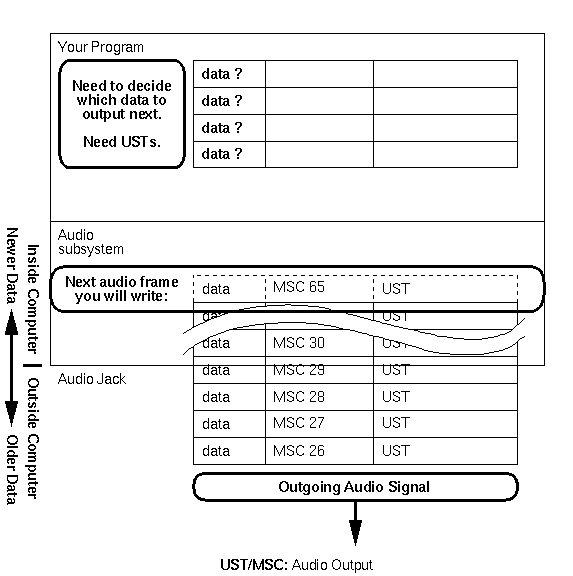
Note that MSCs now decrease (data gets older) as you move down the diagram, since the data flows in the opposite direction. The slot shown in dotted lines is the next audio frame you will write to the AL. It's not an audio frame that is currently in the AL buffer.
As with the input case, one call to alGetFrameNumber() tells you
the MSC of each of your audio frames:
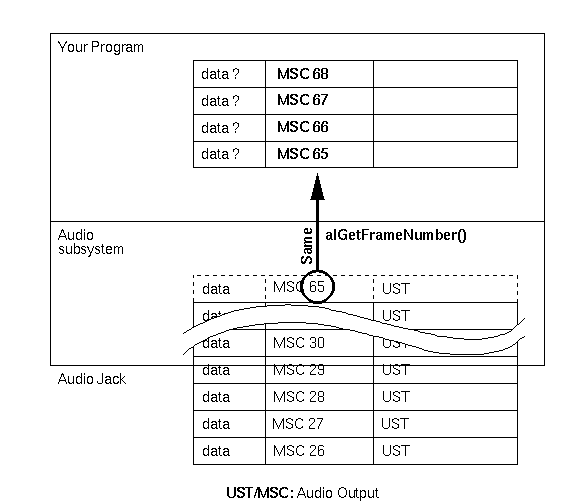
alGetFrameNumber() returns a frontier MSC of 65. This is the MSC of the next frame you're about to write to the port. So the MSCs of your four frames are 65, 66, 67, and 68.
Be careful: In the input case, the audio frame with the frontier MSC is in the AL buffer. In the output case, the audio frame with the frontier MSC is in your buffer.
Continuing to follow the pattern, we get a UST/MSC pair and use it to compute the UST of each frame we are about to write:
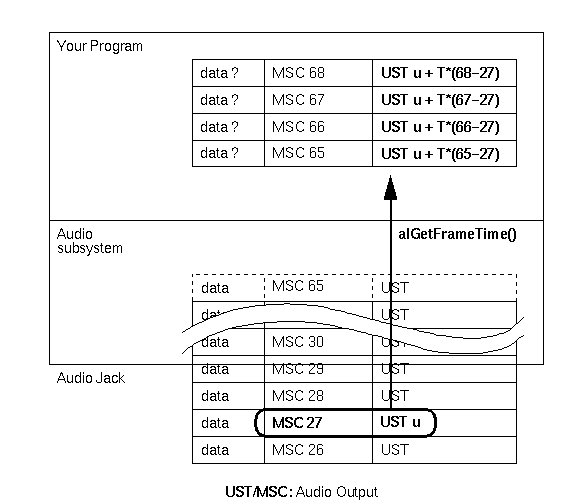
The explanation here is identical to that for input.
Now we know the UST of each audio frame, so we can choose some data to output and proceed with the alWriteFrames().
You can also use the frontier MSC to detect overflow and underflow conditions, and determine their precise length.
Here's an AL example of how to detect overflow in an input buffer:
{
stamp_t newmsc, oldmsc=-1;
/* this is your main data-reading loop, not a special one */
while (1)
{
alReadFrames(port, buf, nframes);
alGetFrameNumber(port, &newmsc);
if (oldmsc > 0)
{
stamp_t M = (newmsc-oldmsc) - nframes;
if (M != 0)
printf("we overflowed for %lld MSCs!\n", M);
}
oldmsc = newmsc;
}
}
Each time you read nframes frames, check to see how much the frontier MSC
has incremented. If the frontier MSC has incremented by nframes+M, then
you know that an overflow just occurred, and that it lasted exactly M sample
periods.
Use this basically identical code to detect underflow in an AL output buffer:
{
stamp_t newmsc, oldmsc=-1;
/* this is your main data-writing loop, not a special one */
while (1)
{
alWriteFrames(port, buf, nframes);
alGetFrameNumber(port, &newmsc);
if (oldmsc > 0)
{
stamp_t M = (newmsc-oldmsc) - nframes;
if (M != 0)
printf("we underflowed for %lld MSCs!\n", M);
}
oldmsc = newmsc;
}
}
Each time you write nframes frames, check to see how much the frontier
MSC has incremented. If the frontier MSC has incremented by nframes+M,
then you know that an underflow just occurred, and that it lasted exactly
M sample periods.
This technique works just as well with the VL.
For more information on how and why this works, check out UST/MSC: Using the Frontier MSC to Detect Errors.
typedef struct {
unsigned size; /* size of compressed image in bytes */
unsigned long long ustime;
unsigned imagecount;
unsigned status; /* additional status information */
} CLimageInfo;
The API is UST timestamping for input and something bizarre for output:
The CL interface for cosmo1 and cosmo2 always deals in fields.
The cosmo1 board is always F1 dominant (see Definitions:
F1/F2, Interleave, Field Dominance, and More). You set cosmo2's dominance
using VL_MGC_DOMINANCE_FIELD on the VL_CODEC node (the default is F1 dominance).
Here is how to tell which of your fields is dominant and which is non-dominant:
If your software makes an assumption about the rate ratio of any two clocks, then it must assure that either:
Say your audio system and your video system are clocked off of the same oscillator (case 1). This would be the case if your video system and your audio system are locked to a common external blackburst signal, for example. If that oscillator is running a bit slow or fast compared to some other oscillator (say the oscillator in your wristwatch), it's no big deal: your audio system will not quite be running at 44100 Hz, but your video system will have the exact same error, so the audio and video you provide to them will stay in sync. This corresponds to case 1 above.
Now say your audio system and your video system are not clocked off of the same oscillator (case 2). This is a common situation on lower-end SGI systems, where users may not have the knowledge, desire, or equipment to slave their audio and video devices to a common oscillator. Then the ratio of the rates of your audio and video system may not actually be 44100/50. As your program runs, the sound coming out the audio jack will slowly drift ahead of the image coming out the video jack, or vice versa. This drift will continue to worsen without bound as playback proceeds.
To take a worst-case example for typical hardware, say the audio oscillator is 50 parts per million fast (44102.205 Hz) and the video oscillator is 50 parts per million slow (49.9975 Hz). After playing for 10 minutes, the video will have drifted 60ms (3 fields) behind the audio, which is quite noticeable. What's worse, since your program continues to send 44100 audio frames for every 50 video fields, but since the devices consume 44100 audio frames for every 49.995 (roughly) video fields, an unbounded amount of video data slowly builds up between your program and the video device (in this case that data will build up in a VL buffer). Eventually you will run out of memory.
Say your application requires field accuracy (audio and video in sync within ±10ms). If your application never deals with movie files longer than 1 minute, then your audio and video will never drift apart more than 10ms in either direction, and no more than one extra field will collect in the VL buffer, so you have no problem. This is case 2a.
If your application can deal with movies of any length, then you
have case 2b. In this case, you cannot achieve any upper bound on synchronization
error or memory usage. You must measure the actual ratio of audio frames
per video field, and adjust the data coming out of the movie file so that
it actually has that ratio going into the devices. Depending on the quality
constraints, this may require sampling rate converting the audio data,
dropping or duplicating video fields, or other tricks. UST/MSC gives you
a way to measure the ratio. To do this, grab two audio UST/MSC pairs spaced
a second or more apart (call them (aust1, amsc1) and (aust2, amsc2)). Also
grab two video UST/MSC pairs spaced a second or more apart (call them (vust1,
vmsc1) and (vust2, vmsc2)). The ratio of audio frames to video fields is:
{
double ust_per_msc = get_ust_per_msc();
USTMSCpair pair = get_ust_msc_pair();
stamp_t frontier_msc = get_frontier_msc();
/* step 1: figure out which MSC you want a UST for */
stamp_t desired_msc = frontier_msc;
/* step 2: compute the UST of that MSC */
stamp_t desired_ust = pair.ust + ust_per_msc*(desired_msc - pair.msc);
}
ust_per_msc is a rate ratio between the UST clock and a device's MSC clock.
UST and MSC clocks are not driven off of the same oscillator in any current
SGI system, so their rate ratio is uncertain. desired_ust will have an
error which is proportional to the error in ust_per_msc and to the distance
you are extrapolating the UST/MSC pair (desired_msc - pair.msc):
| Clock | Where's the oscillator? | |
|---|---|---|
| UST | crystal in your machine | |
| gettimeofday() | no time daemon | crystal in your machine |
| time daemon running | in the timed master or NTP stratum-0 clock | |
| video input | signal contains clock
(oscillator is in upstream equipment) |
|
| video output | internal sync | crystal in your machine |
| genlock/slave sync | sync source signal contains clock
(oscillator is in upstream equipment) |
|
| digital audio input
(AES/ADAT) |
signal contains clock
(oscillator is in upstream equipment) |
|
| analog audio input
analog audio output digital audio output (AES/ADAT) |
sync source set to AES/ADAT input signal | sync source signal contains clock
(oscillator is in upstream equipment) |
| sync source set to internal video | video board provides clock internally
(see video above) |
|
| sync source set to external blackburst | external blackburst signal contains clock
(oscillator is in upstream equipment) |
|
| sync source set to internal | crystal in your machine | |